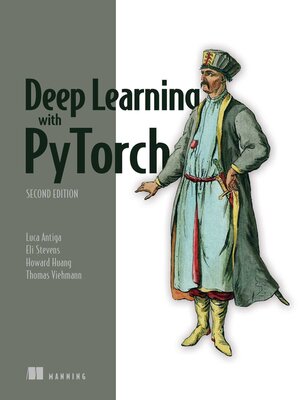
Sign up to save your library
With an OverDrive account, you can save your favorite libraries for at-a-glance information about availability. Find out more about OverDrive accounts.
Find this title in Libby, the library reading app by OverDrive.



Search for a digital library with this title
Title found at these libraries:
| Library Name | Distance |
|---|---|
| Loading... |
Everything you need to create neural networks with PyTorch, including Large Language and diffusion models.
Deep Learning with PyTorch, Second Edition updates the bestselling original guide with new insights into the transformers architecture and generative AI models. Instantly familiar to anyone who knows PyData tools like NumPy and scikit-learn, PyTorch simplifies deep learning without sacrificing advanced features.
In Deep Learning with PyTorch, Second Edition you'll find:
Deep learning fundamentals reinforced with hands-on projects
Mastering PyTorch's flexible APIs for neural network development
Implementing CNNs, RNNs and Transformers
Optimizing models for training and deployment
Generative AI models to create images and text
In Deep Learning with PyTorch, Second Edition you'll learn how to create your own neural network and deep learning systems and take full advantage of PyTorch's built-in tools for automatic differentiation, hardware acceleration, distributed training, and more. PyTorch makes it easy to build the powerful neural networks that underpin many modern advances in artificial intelligence. This second edition has been thoroughly revised by PyTorch core developer Howard Huang to cover the latest features and applications, including generative AI models.
About the book
Deep Learning with PyTorch, Second Edition is a hands-on guide to modern machine learning with PyTorch. You'll discover how easy PyTorch makes it to build your entire DL pipeline, including using the PyTorch Tensor API, loading data in Python, monitoring training, and visualizing results. Each new technique you learn is put into action to build a full-size medical image classifier chapter-by-chapter.
In this modernized second edition, you'll find new coverage of how to develop and train groundbreaking generative AI models. You'll learn about the foundational building blocks of transformers to create large language models and generate exciting images by building your own diffusion model. Plus, you'll discover ways to improve your results by training with augmented data, make improvements to the model architecture, and perform fine tuning.
About the reader
For Python programmers with an interest in machine learning.
About the author
Howard Huang is a software engineer and developer on the PyTorch library. During his tenure at PyTorch he has focused on large scale, distributed training. Eli Stevens, Luca Antiga, and Thomas Viehmann authored the first edition of Deep Learning with PyTorch.
Deep Learning with PyTorch, Second Edition updates the bestselling original guide with new insights into the transformers architecture and generative AI models. Instantly familiar to anyone who knows PyData tools like NumPy and scikit-learn, PyTorch simplifies deep learning without sacrificing advanced features.
In Deep Learning with PyTorch, Second Edition you'll find:
In Deep Learning with PyTorch, Second Edition you'll learn how to create your own neural network and deep learning systems and take full advantage of PyTorch's built-in tools for automatic differentiation, hardware acceleration, distributed training, and more. PyTorch makes it easy to build the powerful neural networks that underpin many modern advances in artificial intelligence. This second edition has been thoroughly revised by PyTorch core developer Howard Huang to cover the latest features and applications, including generative AI models.
About the book
Deep Learning with PyTorch, Second Edition is a hands-on guide to modern machine learning with PyTorch. You'll discover how easy PyTorch makes it to build your entire DL pipeline, including using the PyTorch Tensor API, loading data in Python, monitoring training, and visualizing results. Each new technique you learn is put into action to build a full-size medical image classifier chapter-by-chapter.
In this modernized second edition, you'll find new coverage of how to develop and train groundbreaking generative AI models. You'll learn about the foundational building blocks of transformers to create large language models and generate exciting images by building your own diffusion model. Plus, you'll discover ways to improve your results by training with augmented data, make improvements to the model architecture, and perform fine tuning.
About the reader
For Python programmers with an interest in machine learning.
About the author
Howard Huang is a software engineer and developer on the PyTorch library. During his tenure at PyTorch he has focused on large scale, distributed training. Eli Stevens, Luca Antiga, and Thomas Viehmann authored the first edition of Deep Learning with PyTorch.







